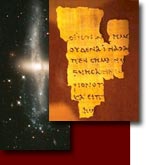| Site Map | Contacts | Links | Newsletter | |
Genesis 1:24-31 DAY 6
Behemoth
Behemoth in contrast to the leviathan is a giant land animal, not a sea creature. There seems to be a similar animal in a Ugaritic text BH called Žgl il Žtk meaning "the ferocious bullock of El" (Pope 1965, 321; KTU 1.3 III 44). Another text describes an animal as having horns like bulls, humps like buffalo, and the face of Baal (Ibid; KTU 1.12 I 30-33). This beast may be the same as the Sumerian and Akkadian "bull of heaven" who was slain by Gilgamesh and Enkidu in the Gilgamesh Epic (Ibid., 322; ANET, 83-85; Heidel 1946, 53-55).
The description in Job 40:21-23 seems to allude to the area around Lake Huleh which was filled with buffalo. His tail is like a cedar branch that can easily bend or sway (Pope think this refers to sexual arousal). This does not mean his tail was as long as or as big as a huge cedar tree for verses 21-23 say, "Under the lotus plants he lies, hidden among the reeds in the marsh. The lotus conceal him in their shadow" (NIV). Reeds and lotus can not hide a huge dinosaur.
Gilgamesh Epic
The Epic of Gilgamesh describes the battle with the Bull of Heaven. Enkidu seized the Bull by the horns. "The Bull of Heaven foamed in his face, it brushed him with the thick of its tail—Gilgamesh followed the bull, he seized the thick of his tail, he thrust the sword between the nape and the horns and slew the bull" (Sandars 1972, 88; ANET, 85, 505). The "thick of his tail" does not mean a dinosaurís big tail, but the tassel at the end of its tail. The Akkadian is ku-bur zib-ba-ti-su, meaning "thickness of his tail" (ANET, 505). "It refers to the tassele at the end of the tail in contrast to the thin middle part" (Ibid., note 29). The horns of the bull are plated with lapis two inches thick, weighing thirty pounds, and holding 105 gallons each (Heidel, 55). This was a huge mythical bull which is associated with the constellation Taurus, the bull (Black and Green, 49).
Gilgamesh also battles another monster called "Huwawa" (Babylonian) or "Humbaba" (Assyrian) who lives in the Cedar Forest. Huwawa is described by "his roaring is the flood-storm, his mouth is fire, his breath is death" (ANET, 79; Jacobsen, 200). This does not mean it breaths fire. This is poetical language describing its snort that looks like smoke on a cool morning.
Dragons
The KJV uses the term "dragon" which comes from the Greek word drakon which means "serpent." It refers to a monster with a scaly snake like body. The Greek New Testament uses drakon 12 times only in the book of Revelation which the KJV translates as "dragon" (Rev. 12-13, 16:13, 20:2). The dragon in Revelation has seven heads similar to the leviathan in Ugaritic and Psalm 74:14 (Gibson, 50, 68; Walace, 290). Satan is called a "dragon" in Revelation 20:2.
In the Old Testament the KJV uses the term "dragon" for the Hebrew words tannim meaning "jackals" and tannin meaning "serpent, or sea monster" (BDB, 1072; Gesenius, 868-9). It seems the KJV mistranslated these two separate words. Tannim is from the root tan meaning "to howl" and tannin is from the root tanan "to smoke" (Ibid.). Jackels are known for their howling, and are associated with desolate areas. Tannin or "smokers" probably came from seeing the spouts of whales or the snorting of animals which looked like smoke coming from a fire inside. Our warm breathe in winter looks like smoke. This is probably how the idea of fire-breathing dragons started. The Hebrew is not referring to any dinosaurs.
In the LXX the story of Bel and the Dragon is added to the book of Daniel. Daniel exposes the priests who were eating the food offered to the god Bel. Cerise has them killed. Daniel then feeds the living dragon pitch, fat and hair so that it dies. The Babylonians force the king to put Daniel into the lionís den where he is delivered by God. Danielís enemies are cast into the den and immediately eaten.
The Greek word for "dragon" means "serpent" not dinosaur. In Babylon they worshipped the god Nina in the form of a serpent (IBSE, Vol.1, 428-9).
Giants
In Homerís book Odyssey (Book 9), Odysseus lands on an island of giant Cyclopes. Later the Greek historian Thucydides stated that the island of Sicily on the slopes of Mount Etna was the home of the Cyclopes. Giant bones and one eye skeletons were found there in the Middle Ages, but these bones were of mastodons, not humans. A mastodon skull looks like it has one giant eye in the center of its head. There is an interesting new book entitled The First Fossil Hunters by Adrienne Mayor who shows how fossil bones were seen as giant men and other strange creatures (Princeton, 2000). See also On the Track of Ice Age Mammals by Antony Sutcliffe (Harvard University Press, 1985).
Large fossil bones were thought to be from giant humans, or an angel that had fallen from heaven. Pliny says that the skeleton of Orion was discovered on the island of Crete which was 35 feet long (Gayard-Valy, 15-18).
Unicorns
The KJV mentions "unicorns" nine times (Numbers 23:22; 24:8; Deuteronomy 33:17; Job 39:9,10; Psalm 22:21; 29:6; 92:10; Isaiah 34:7). It is an unfortunate translation of the Hebrew reem which means "wild ox" (BDB, 910b). It seems that the LXX translation made the error which was carried over into the Latin unicornis.
The idea of a unicorn probably came from seeing a rhinoceros. In the Middle Ages when fossil tusks or horns were found, they were said to come from unicorns (Gayrard-Valy, 22).
